December 15, 2014 at 10:42 pm
Reuters just recently posted a video of Star Wars like weapons. I had to share this.
You can view an older video of the Laser Weapons from 2010 here.
Back when I was in high school, there was talk of Reagan’s Star Wars program to shoot lasers up at Battle Mirrors and bounce them down into the Soviet Union. It never worked because of atmospheric refraction. But as a senior in college, I got to spend two weeks working at Lawrence Livermore National Laboratory (in 1992) where they had just declassified the Laser Guide Start Program, which was one of the few successful parts of the original Star Wars programs.
By Gary Garber
|
Posted in Physics
|
December 15, 2014 at 9:59 pm
Here is a great video posted recently on the LEGO Engineering website where Chris Rogers explains why we need STEM education. There is a transcript of this video at the above link.
By Gary Garber
|
Posted in Physics
|
December 13, 2014 at 10:49 pm
On Thursday Leonardo and I attended the Grand Reopening of the CEEO at Tufts. They were having the Ribbon Cutting.
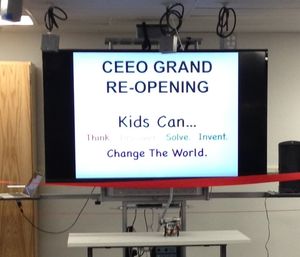
Here, Leonardo was building an EV3 Robot for a non-wheeled robot race
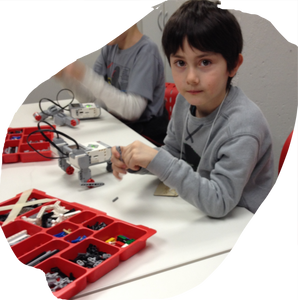
Leonardo Won! Mainly because his robot went forward and the others went backwards. 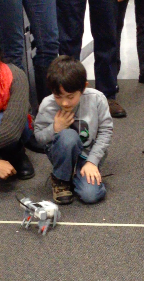
Here, Leonardo is playing a real live gain of space invaders. A joystick controls a hovering spaceship driven by an EV3. This was a project from the intro to programming engineering class at Tufts. 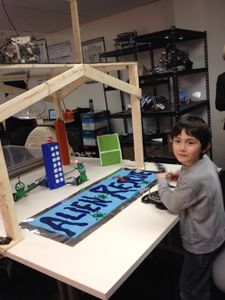
These are the trophies that were awarded to those who won the robot races!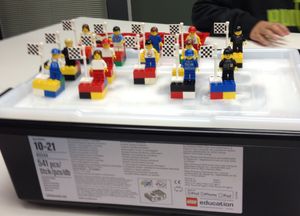
This is what you see when you enter the CEEO.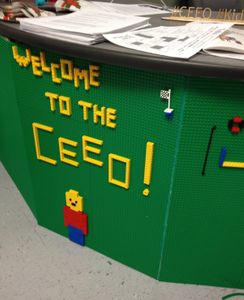
By Gary Garber
|
Posted in Physics
|
September 17, 2014 at 11:03 pm
I was interviewed a few weeks ago for the Curriculum section of this week's issue of eSchool news. The article is by Laura Deveney and titled Project Based Learning Moves into Classrooms. I first learned about Project Based Learning through a summer workshop with the New England Board of Higher Education PBL Program. I participated in the Photon PBL program and build a photosphere with my students for Watt's My Light.
By Gary Garber
|
Posted in Physics
|
September 10, 2014 at 10:08 pm
As I prepare for parents night here at BUA, I often get questions about the pedagogy employed in my classroom. I often turn parents to this article from Science Service, (who publish Science News) about the problems with the Scientific Method. There are some nice quotes from Heidi Schweingruber, director of the Board on Science Education at the National Research Council.
"In the future, she says, students and teachers will be encouraged to think not about the scientific method, but instead about “practices of science” — or the many ways in which scientists look for answers."
“In the past, students have largely been taught there’s one way to do science,” she says. “It’s been reduced to ‘Here are the five steps, and this is how every scientist does it.’“
But that one-size-fits-all approach doesn’t reflect how scientists in different fields actually “do” science, she says.
“Ninety percent of the experiments I did as a scientist didn’t work out,” says Bill Wallace, a former biologist with the National Institutes of Health.
You may have noticed the article also quotes a mild mannered physics teacher from Melrose.
By Gary Garber
|
Posted in Physics
|
September 10, 2014 at 9:54 pm
This week in physics we have started playing around with programming LEGO Mindstorms robots using LabVIEW. I received a note today about an announcement from National Instrument, the maker of LabVIEW, that I am on their list of Elite Educators.
What kinds of things can you do with National Instruments toys? Here is myRIO with Tetrix, which is the metal version of LEGO.
By Gary Garber
|
Posted in Physics
|
September 4, 2014 at 10:40 pm
Today I gave my Webinar comparing VEXIQ to EV3. You can catch it on the O'Reilly site. It should be archived soon.
On the way into school, I heard that LEGO has now surpassed Mattel as the largest toy company in the world. This is partly due to increase sales and mechandising due to the LEGO movie. You can read about this in the Wall Street Journal or USA Today. I was excited to read that there is a second LEGO movie in the works and a LEGO Ninjago movie in the works. The LEGO Movie is touching for those of us who perhaps work too hard and need to remember to spend more time 'playing with LEGOS' with our own kids.

By Gary Garber
|
Posted in Physics
|
September 2, 2014 at 9:03 pm
Today was the first day of classes. In physics today we learned to use InterLACE with an activity called LEGO Serious Play. The students build something to represent themselves from LEGO and shared it with their peers.
This year I am also teaching ASERP (or the Junior STEM Seminar) for the first time in over five years. 21 kids in the class! Wow!
This week I have been busy preparing for the Webinar I am presenting on Thursday. The Webinar is being put together by O'Reilly, one of the distributors for my LEGO Mindstorms book. The title of the Webinar is LEGO EV3 vs. VEX IQ Robotics, a Comparison in Sensor Control Systems.
By Gary Garber
|
Posted in Physics
|
August 9, 2014 at 8:12 pm
Can you explain how these work?
By Gary Garber
|
Posted in Physics
|
August 3, 2014 at 10:15 pm
Thursday was a busy day finishing our rockets. Everyone finished their Estes rockets and most people started their bottle rockets.
Thursday afternoon Glynn Holt talked to us about his experiences at NASA and what it was like to go through the astronaut training program as a Mission Specialist and the details of his experiment which did get to fly on the Space Shuttle.
We finished the week building and launching our rockets. We launched the Estes rockets early Friday morning, and only lost two of them into the Marshes this year.
Glynn Holt and his students showed us a lot of cool acoustics experiments Friday morning. After that, we went across the hallway to explore the laboratory of the BU Rocketry Team. Many thanks to Ben Ha for giving us a tour of the lab.
David gave a nice talk on navigation and how to read a flight map Friday afternoon. We did an activity where using the flight maps we did a flight plan using way points.
After the navigation exercise we went to launch our bottle rockets. We didn't have too many complete bottle rockets, but those we had went quite high. We used a rocket launcher from Edmund Scientifics. This is a nice backyard launcher, which goes up to 60 psi. If you want to hard core bottle rocket launcher, you need a Big Foot which will take you up to 100 psi.
By Gary Garber
|
Posted in Physics
|







